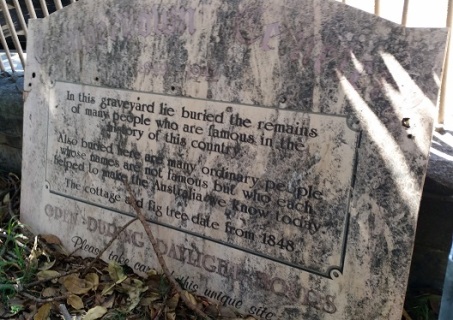Photo: The Moores Family Plot
The Camperdown Cemetery is situated in the centre of Newtown, a densely populated inner-city suburb of Sydney. It shares the same area as St Stephen’s Anglican Church and covers an area of approximately four acres. It is a listed property with the Heritage Council of NSW as an important national site. Its beginnings are rather interesting – in 1848 a group of influential Anglican businessmen purchased the land to create a new cemetery. At that time the land was approximately twelve acres, and was land that had originally been granted to William Bligh when he became the fourth Governor of NSW. The area was beautifully landscaped with a central circular pathway and enclosed with high paling fencing. A number of oak trees were planted and a Moreton Bay fig tree was planted at the entrance. Camperdown Cemetery was open for business!
 The Moreton Bay Fig Tree
The Moreton Bay Fig Tree
This cemetery was the final resting place for a variety of people of all denominations and from the influential and prominent to humble convicts were interred there. The site would become the main burial area for Sydney and would prove to be an extremely lucrative investment for its shareholders, as over the next twenty years, between sixteen and eighteen thousand people would be buried there. In 1867 the cemetery was closed down because it was full to capacity and unfortunately, over the next seventy years it was allowed to fall into disrepair. By the early 1940s the area was completely overgrown and many of the gravestones had been vandalised.
It was mid-morning when we got to St Stephen’s Church and the majestic, 165 year-old fig tree dwarfed us as we walked through the entrance gates. We passed a number of people walking their dogs and several couples were sitting chatting on the grassed areas. We had a map of the cemetery which we’d printed off the internet, but we still managed to get lost as we searched for the Moore family plot. From what I learned during my research, several acres of the original cemetery were allocated for development of a public park, which would serve as a recreational area for the growing population of Newtown in the 1950s. According to the records the removal of the gravestones to make way for the park was a heritage disaster as many of the memorials were damaged. The cemetery is now walled in with gravestones unceremoniouly propped up against the walls and is, as Jan Mallyon had mentioned in her email to me, in a desperate state of disrepair.
 St Stephen’s Church Newtown
St Stephen’s Church Newtown
I eventually located my ancestors family burial plot in Sections F/G of the cemetery. Several gravestones were half enclosed in a derelict and rusted wrought iron fence and because the gravestones were all fashioned out of soft sandstone, the inscriptions were barely visible. I could make out Captain Joseph Moore and Ann Moore whose graves were lying side by side and also Henry Moore and his wife Elizabeth. I perched myself to one side of Ann Moore’s gravestone and just cried. How sad that these wonderful historical relics had been allowed to deteriorate into this. I wondered if any of my living Moore relatives had ever seen this amazing family burial site, and if so, why hadn’t any effort been made to restore it? Perhaps its value had simply been forgotten over time.



I promised myself as we were leaving that when I was in a financial position to do so, I would commit to restoring the family plot, so that all future Moore descendants would have the experience and pleasure of seeing the final resting place of some of their most interesting and illustrious ancestors.
I believe that the Camperdown Cemetery is overseen by the Camperdown Cemetery Trust and every effort is being made for the preservation of this historic landmark.

